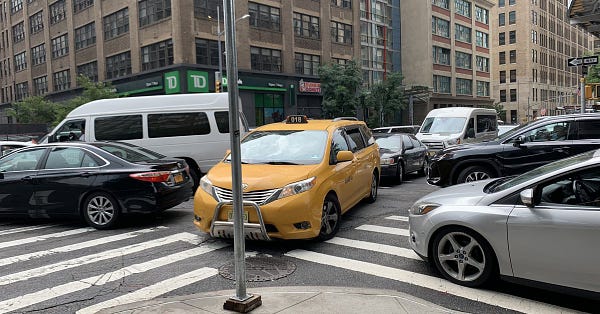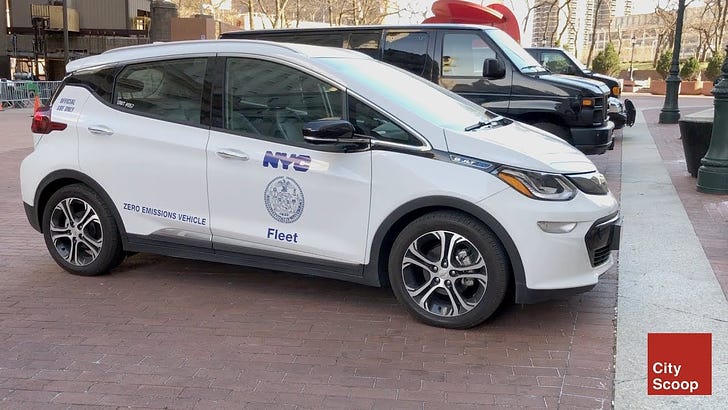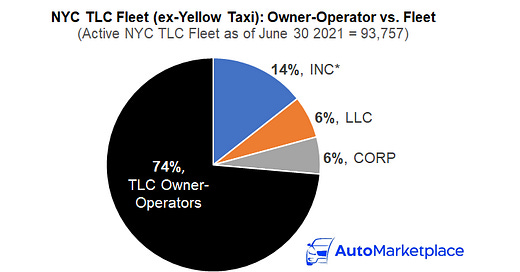

Discover more from AutoMarketplace
NYC Wants To Reduce City Fleet. Another Reminder For The TLC Industry About Plate Cap
The writing on the wall is that the FHV License Pause (aka TLC Plate Cap) is unlikely to be lifted. Drivers & fleets may want to consider plating WAVs, buying medallions or (clean) FHV Corporations

AutoMarketplace NYC covers the for-hire transportation industry and automotive news. Check out AutoMarketplace on YouTube ▶️
New York City’s fleet currently consists of 24,526 vehicles:
Emergency vehicles: 9,579 (39%)
Agency work trucks: 7,893 (32%)
General use cars: 4,406 (18%)
Sanitation trucks and sweepers: 2,648 (11%)
It’s unclear if this figure includes NYPD’s fleet of 9,000 vehicles & 115 motorcycles 🚓🚓🚓🚓🚓
That's a lot of vehicles 🚗🚗🚗🚗🚗
For example, imagine if the average vehicle cost (cost of acquisition) was $30,000. That would imply NYC has spent over $750 million (🤔) on vehicles, albeit over several years. Some NYC fleet vehicles, like sanitation trucks, also cost a lot more than than an average car (sometimes well over $100,000!).
So, when NYC Mayor Eric Adams, recently announced a continuation of the previous administration's goal of reducing the City’s fleet, it's notable. Many people living outside of New York City might be confused about goals related to reducing cars, including vehicle caps, that can travel within the City. If it was announced in Atlanta or Houston that you couldn't add your car to the Uber rideshare supply or that you need to pay $10 to enter downtown, it would likely be met with confusion, maybe even outrage.
The difference with a very dense urban environment like NYC versus other cities (Only in NY 🍎 if you will) is that there is limited travel and living space for residents and visitors. It is probably understood by most that if there are too many cars on NYC roads, no one could effectively move in the City. It would cause a lot of congestion, which also has other negative impacts (i.e., pollution levels). Related to rideshare “vehicle caps”, it's also probably understood that if every NYC street corner had a hot dog stand, that could cause several issues from "race to the bottom" business practices (i.e., man with kids vs. teenager) to health/sanitation concerns.
I'm a capitalist, and I don’t mean to say that in a dogmatic tone. Where government doesn't need to be involved, it shouldn't be involved. I'm also pragmatic, there are certain places where government needs to be involved. In addition, there are certain times where SOME government involvement is needed, but not FULL government involvement. Governing is a tricky business and I don't want to sound like a laissez-faire, “everything will work itself out” type of person. At the same time, bad government and governing can have dire consequences, from impacting faith in the rule of law & systems to budget deficits to crime.
With this seemingly tangential commentary above, let's get back to the Mayor & City’s fleet reduction announcement.
“We must reduce the reliance on private cars on our streets and New York City can set an example for all New Yorkers” - Manhattan Borough President Mark Levine
“Efforts to reduce car ownership across New York City should start with the city government fleet. Credit to Mayor Adams for doing the right thing and substantially driving down the city fleet” - NYC Councilmember Lincoln Restler
Combine this announcement with other recent governmental actions and statements that we, along with other outlets, have covered - from new streetscape ideas to congestion pricing to the FHV License Pause (aka TLC Plate Cap).
Congestion Pricing, Bike Lanes & NYC Public Transport
Congestion pricing is a City (and NY State) priority for several reasons. One being that it will provide critical funding for the MTA, which is in bad financial shape.


In addition, implementing congestion pricing aims reduce the number of private cars that come to the City (🤔). Less private cars, presumably means more use of public transport and also non-polluting forms of transport, such as walking and biking.
Any NYC driver can see what's happening. The City’s priority is reducing cars, creating more pedestrian friendly neighborhoods and pushing for wider use of public transport from subways to buses. This doesn't mean cars are fully disappearing from NYC streets, but it does mean there will be less cars for all the reasons mentioned above and for other important reasons I have not mentioned in more detail (i.e., Vision Zero).
Thinking Through Impacts On FHV License Pause (aka TLC Plate Cap)
We've spoken at length about where we think the TLC Plate Cap is headed (see link below). When you additionally layer on the City's continued goals of not only reducing their own fleet, but reducing cars (although TLC cars are more efficiently utilized than private cars) travelling in the five boroughs - it's just very hard to see the TLC Plate Cap being lifted in the near future. In addition, as we've written about recently, the taxi medallion debt restructuring, which included a City-backed guarantee, makes it even more unlikely the TLC Plate Cap is going away.
I know these predictions will disappoint some drivers, black car & livery base owners who are (understandably) looking for a mechanism to access additional FHV licenses and smaller fleets. As I've previously disclosed, we started out in this industry as fleet owners before launching AutoMarketplace. We don't have a “mega” fleet and honestly if the TLC Plate Cap “opened”, given our focus on luxury vehicle leasing, we could grow our business rapidly. However, as I stated above, I'm a pragmatic capitalist that also understands the City's thinking.
Therefore, for those NYC TLC drivers, bases and smaller fleet owners looking to access their own/additional FHV license(s) there are three options that remain:
Plating a wheelchair accessible vehicle (WAV) (exemption remains for now)
Buying a yellow taxi medallion (if you can find one for sale)
Purchasing an FHV Corporation that has claim to a single FHV license OR forming a group of drivers 👩🏿👩👨🏾👨🏻🦳🧑🧑🏿👨🏽🦲 that can acquire an FHV Corporation that has access to several FHV licenses
We're going to do a more fulsome article on how much we think NYC TLC drivers should pay for a taxi medallion or FHV Corporation, so be sure to subscribe!
I will quickly say two things though because it concerns us 🚩🚩.

An individual CANNOT sell their FHV License (TLC Plate). Any individual that is advertising that, is misinformed. Individually-owned cars that have access to an FHV license CANNOT transfer the claim to their FHV license to another party. So in simple terms, 🚩AN INDIVIDUAL CANNOT SELL THEIR TLC PLATE(S) IF IT's UNDER THEIR NAME🚩

If you do purchase an FHV Corporation, you need to do due diligence. The obvious diligence items will include investigating outstanding lawsuits, NYC parking tickets and E-ZPass violations. However, and this especially applies to FHV Corporation’s that have access to multiple FHV licenses, you/your group needs to ensure New York State sales taxes were paid. If you/your group purchases an FHV Corporation that has not paid its New York State sales taxes, 🚩YOU/YOUR GROUP COULD FACE SIGNIFICANT LEGAL & FINANCIAL LIABILITIES🚩
The above is not investment advice and should not be interpreted as such. We are simply communicating how we think things will play out in the NYC TLC industry at this moment in time. Drivers need to be aware of where the industry could head and consider their options thoughtfully.
As always, let us know your thoughts!
AutoMarketplace NYC covers the for-hire transportation industry and automotive news. Check out AutoMarketplace on YouTube ▶️












